The best training possible
But not the best training
BY KELSY GIBOS
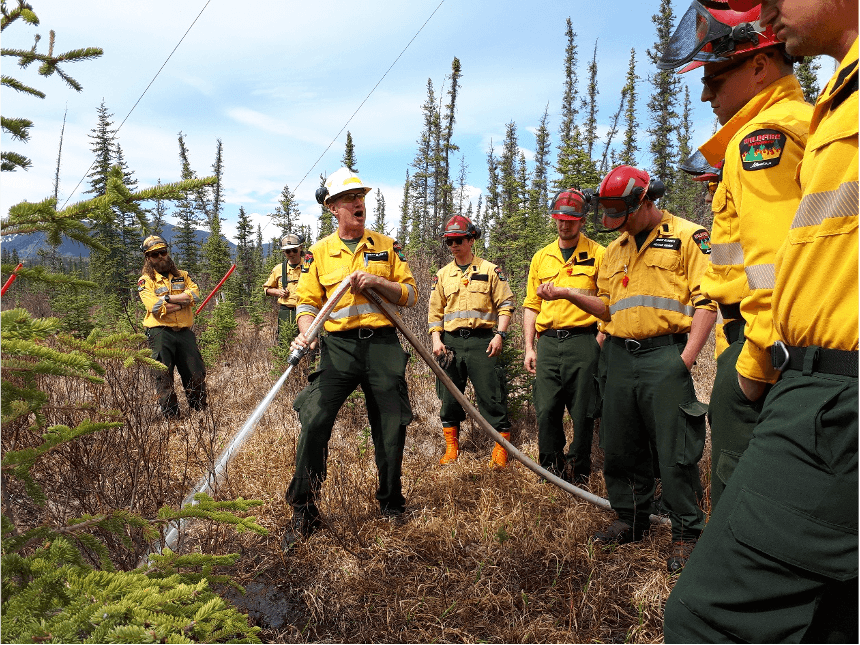
COVID-19 has changed so many components of our day-to-day wildfire operations; not one discipline has been left untouched.
The 2020 wildland fire training season in Alberta involved some successes, suggested some improvements and provided a list of lessons learned that may be useful for others in the wildfire community.
This quote, from our after-action review on the 2020 training season summarizes the overall sentiment of that spring: “We gave the best training possible, but it was not the best training.”
The Hinton Training Centre, north of Edmonton, is responsible for delivering provincial, national and external courses; this includes both wildfire and forestry topics ranging from basic wildfire crew member to wildland fire behaviour specialist and helicopter co-ordinator to timber scaling.
In a normal – pre COVID19 – year, a handful of staff lead, develop and co-ordinate delivery of almost 70 different courses in a mix of in-class (70 per cent), blended (20 per cent) and online (10 per cent) delivery.
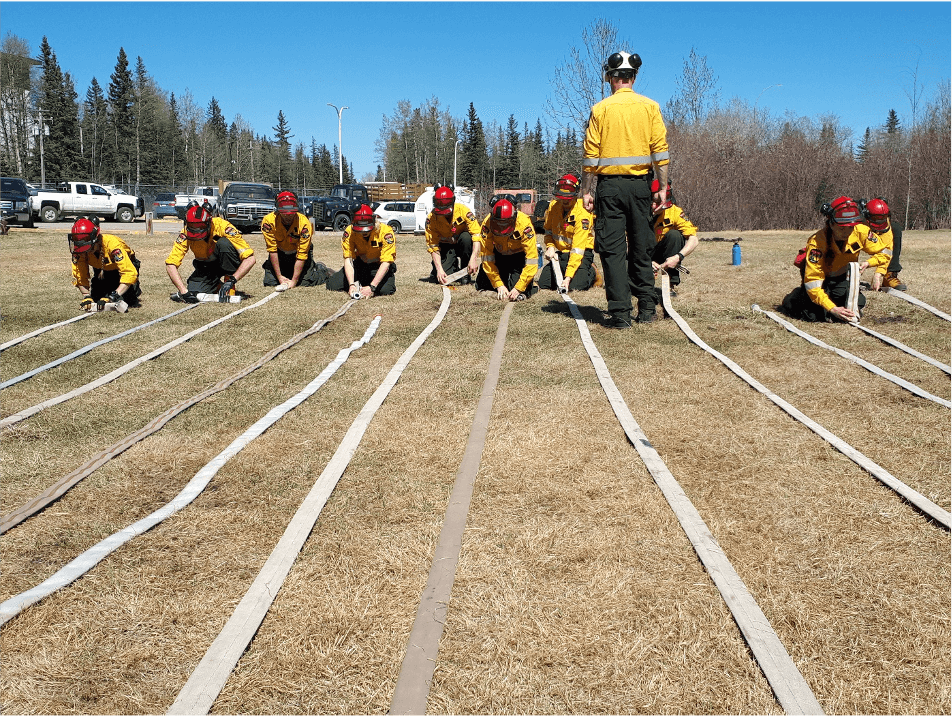
COVID-19 arrived in Alberta in early spring of 2020. Averaging more than 1,500 new cases a day at its peak, the Alberta government imposed several social-distancing protocols across timing for the highest density of training courses. Meetings of groups of first responders were constrained in size and many provincial facilities closed to the public, including the Hinton Training Center. Courses deemed non-essential were cancelled and training specialists realized that the traditional, intensive, in-person training format of recruits and crew leaders would not be possible in 2020. With no back-up plan, we set out to find a way to train 300-plus seasonal employees.
The immediate training needs focussed on training our seasonal staff; all spring training for permanent staff was postponed.
Five training specialists designed and delivered two wildfire crew leader courses and three wildfire crew member courses in a real-time – instructor-led virtual classrooms, or in a synchronous fashion. These courses are more than one week in duration, and, historically, are a combination of live lecture, group exercises and a number of field labs.
The simplest compromise was to lean on the local forest area staff to help with training delivery instead of centralizing it at the Hinton Training Centre. This eliminated the need for firefighters to travel and removed responsibility to feed and house them away from their home unit within COVID guidelines.
There are 10 forest areas in Alberta, each with a hierarchy of permanent staff made up of operations officers, wildfire technicians and forest rangers.
The local area became responsible for dealing with logistics – this included finding a training space that met physical distance requirements of two metres of space between students. This challenge was compounded by widespread facility closures. The forest areas also had to set up computers, screens and projectors, microphones and video cameras to accommodate the live lecture component of the training. Many areas did not have the bare minimums to meet this requirement, and corralling all the technology was a steep learning curve!
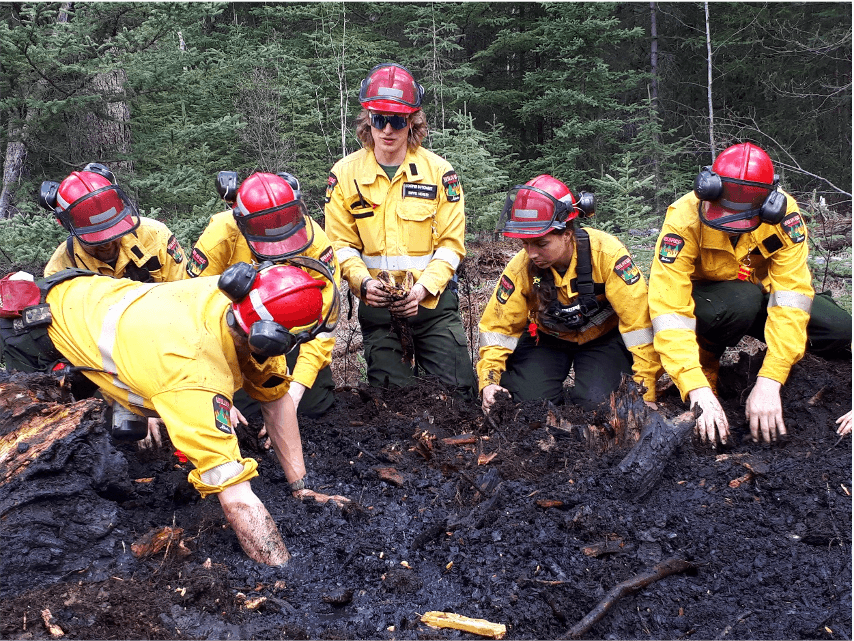
To accommodate limitations related to the pandemic, training specialists quickly reworked the practical skills evaluation templates, quizzes and exams to a format that could be delivered by staff in their home areas. This material, along with reference binders, was organized, printed and shipped out to the 10 forest areas across the province to chosen local training contacts. In order to deliver the field labs, moderators and mentors were identified in each of the areas, and instructions were prepared on how to deliver the hands-on field lab components.
The training specialists had to find a platform that was best to support the live lecture series. Many used PowerPoint supplemented by live demonstrations such as fuel characterisation, practical use of the fire behaviour field guide – the Red Book, pump troubleshooting, and radio operations. Different platforms were explored, including Webex, Skype, Zoom and a document-viewing camera like the Ladybug were all trialed. The final delivery used Skype and the Ladybug camera together to show slides, videos and live hands-on activities.
In many instances, video shared with students to demonstrate important principles, such as fire behaviour, was choppy and the quality was lacking.
The standard final exam for the WFCM course has both a nationally recognized written test and a practical field evaluation, during which skills such as map reading, compass use, radio competency, melon rolling and pump knowledge are tested at hands-on stations. The forest areas administered the tests at their leisure and reported performance and grades back to the Hinton Training Centre.
So how did we do? Here’s a look first at the feedback from the students who participated in the wildfire crew leader and wildfire crew member courses that we delivered in spring of 2020.
The good:
The mentors who were selected to assist with the course were critical for the students to be able to ask questions, seek clarification and so forth. Most of these people were chosen based on their background skills and knowledge, but none had any form of instructor training; some were experienced seasonal employees and some were permanent full-time staff. The mix was great to help build relationships between the seasons’ new firefighters and the local area staff. If a mentor was not available in the local area, it was noted as detrimental to the training success.
The not so good
- Students missed the interaction with other crew leaders and members from around the province, which happens on site at the Hinton Training Centre. Participants bring diverse perspectives, experiences and ideas, and the networking component is super critical for when they all bump into each other while working together on larger fires later in the season.
- Questions and discussion about things like strategy and tactics, aircraft operations and fire assessments were missing. The silence was notable.
- Asking questions via the video conferencing software was virtually impossible; it was difficult to get instructors’ attention, and challenging to communicate. We all know what it is like to try to chime in during a web meeting!
- Technology was frustrating; not all the areas managed to get appropriate technology set up in time. There were issues in permitting video audio and an annoying delay in video transmission
- The forest areas needed more time to complete the on-site training and field labs. Many students felt like the delivery was rushed. A common comment was that the hands-on training reinforces lecture material, and without it, the training was incomplete.
There were definitely a few more not-so-goods than goods. At the end of last season and the beginning of this season, the training specialists got together to share their thoughts on how this first fling at synchronous online training went.
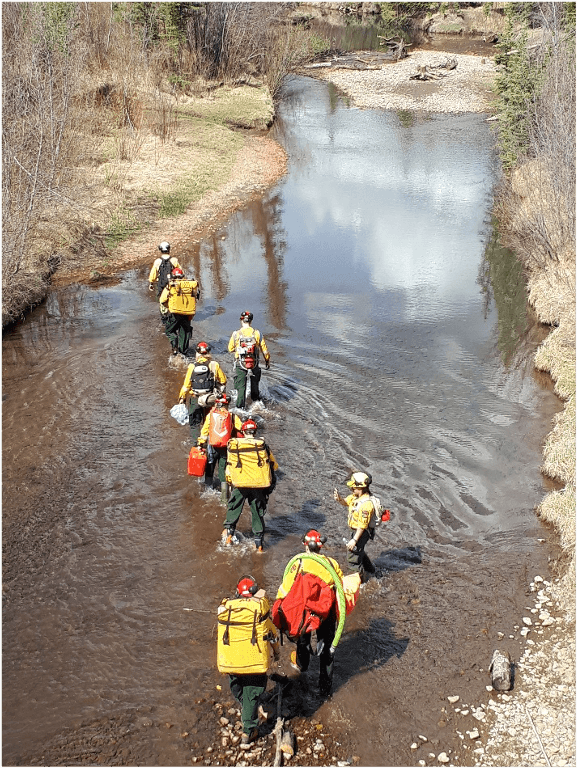
Admittedly, we got the training done as best we could, but it wasn’t the best training we had ever delivered. Most of the training specialists felt that the quality and consistency of the training was adversely affected and our provincial standard of training was not fully achieved. If live virtual training is to continue with support from local resources, there are a number of items that are immediate areas of opportunity for improvement.
Because each forest area was left to its own devices to deliver the training, it was often done out of order and in a rushed manner compared to the standard in-person delivery. This was very apparent in the skills-based, hands-on objectives, which were poorly rated by the students. If additional training requirements are going to continue to be necessary from staff at the area level, the field exercises need to be better documented with stronger lesson plans and clearer learning objectives communicated to area staff. The training specialists deliver this stuff year after year and know it inside out, but there were gaps in the written descriptions that forest areas had to fill, which led to some provincial discrepancies.
Mentors and local support were mostly chosen based on their availability, rather than their abilities as instructors. This meant that many people delivering training weren’t actually trained to be trainers; not to say they didn’t make it work, but perhaps in the future we should look at creating a list of local resources who have been formally tagged for training. They could attend adult instructor training or spend time with Hinton training specialists to learn the ins and outs of adult learning.
Pushing this last-minute training onto the forest area placed huge pressure on local staff. It is estimated that both courses together required about 500 full-time equivalent days to deliver (compared to 100 with our standard central delivery that normally happens at the Hinton Training Center). Spring time is generally really busy – we experience a lot of our large destructive fires by the middle of May, and this spring training really impacted local rosters for duty officers, response officers and standby. To add to that, there was a ton of escalating workload at this time of year, and area staff worked to open lookout towers, onboard new hires and get seasonal work programs up and running. This is the Hinton Training Centre’s time to shine and instead we had to pile it on to folks who already had a pretty busy spring lineup. Fortunately, we had an unseasonably wet start, with no major fires that spring.
A quote from the evaluations filled out after the course from a permanent area staff member: “The week before the May long weekend, which is often one of the busiest weeks of the year, we had no staff available to respond to wildfires. Nearly every permanent (along with many seasonal) staff member in the area was involved in training/commencement of staff . . . Had it even been an average May where it wasn’t as wet, [we] would have been in trouble.”
Another big issue highlighted by the students was this lost nuance of sharing experiences, exploring questions and relating relevant situations. Things like leadership, safety, fire behaviour and fire assessments are so difficult to teach one-sided, so someone spewing a lecture from a PowerPoint slide simply cannot connect that human dimension required to make the topics real.
There are exercises embedded in a number of the presentations that are meant to break up the lecture and engage discussion in the classroom. Even just getting students to read things off of slides brings them back into the discussion – this was super difficult to recreate in that Skype platform. The conversation was very one-sided and participation in discussion especially with the instructors was very limited
I don’t think it is possible to fully recreate the comradery that is present in a live classroom, but there are so many new online tools and tricks to keep virtual audiences engaged. The training specialists had such a short amount of time to pull together a digital platform that they did their best with what they had. It has definitely highlighted the need to learn more about digital delivery and how best to cater to adult digital learners. The combination of the virtual delivery and a slow fire season probably means that there was an overall lower retention of knowledge.
The glitchiness of the technology really took away from the course delivery. There was inconsistent equipment and technical expertise at each forest area that can remedied fairly easily. Some of the internet at the base camps where training was being delivered was not adequate – a lot of the embedded videos were lagged and terrible, so much so that they had to be skipped during the presentation. This meant that videos showing fires of different intensities, flights of different assessments and tours of various hose lays were not able to be shown. I guess this highlighted our dependency on in-person training with no foresight into preparing ourselves to have to do it all remotely. Did anyone really see the seriousness of this pandemic in the beginning? How could we have planned better to be prepared to be isolated to our own home areas? Technology now seems like the obvious fix: there have definitely already been improvements in our digital accessibility, even at our more remote camps.
That assessment was a bit harsh on us; let’s have a look at some of the successes from last year.
First off, the few folks we have here doing all this training are phenomenal; what they managed to pull together and deliver in such a short period of time is outstanding. Operating in the pandemic has really highlighted the resilience and resolve of our staff. I’d pat myself on the back here but I actually missed out on all of this while I took a year of maternity leave. I commend my coworkers for the effort they put into this, especially with all the barriers and uncertainty they faced and big kudos to the area staff for stepping up and getting it done for their home forest area.
The exposure to the new world of virtual learning environments has really caused us to take a new, refreshed outlook on our suite of training and we’re working toward modernizing our delivery model. In the last year, we have converted nearly a dozen courses into a fresh shiny online learning platform. These courses are self-paced and stand alone or asynchronous training and are available to do from the home area (or home office!)
With the development of all of these new asynchronous online courses, we have improved access; there are more and more people signing up than ever before as we reach into this wider web. A number of permanent staff often find it difficult to travel to Hinton for training due to family commitments, rosters, workloads and the like; being able to work through a course online makes it so much more accessible to our staff. Increasing training deliver options allows us to target a larger audience as well as reduce costs and travel.
Finally, here are a few lessons learned. I asked the training specialists to summarize lessons that they would like to share with the rest of wildfire fighting community and here is what they came up with. If you are looking to move forward with your virtual training arsenal, consider the following:
It is very different teaching to a computer screen. People don’t laugh at your jokes or engage in your anecdotes. You will need to put in effort and enthusiasm to engage learners. Channel your inner DJ and imagine the audience enjoying what you are saying! Do some research on ways to make your presentations exciting with add-ins like interactive polls and whiteboards.
Because of the lack of banter, synchronous virtual training goes faster than in-person. Schedule more material to fill in the gaps, or consider giving more breaks to your learners.
You cannot take classroom, in-person training material and deliver it live online. Moving to a virtual delivery requires a reassessment and overhaul of materials, methods and course sequencing. All forms of online learning put a lot of the onus on the student to read the material, follow along and participate in group chats. You need to motivate them too.
Support your local area; give them what they need to make sure the students are successful in-house. Technology is key: make sure it works! Build strong lesson plans with gear lists, step-by-step instructions and clear learning objectives. Also, try to find the best local folks to provide support and that missing comradery piece.
Lastly, find a technology that works for you. There are so many different platforms, all with varying abilities to improve engagement, host evaluations and deliver exams. Take the time to review your online training needs and choose a technology that enhances what you already have and encourages you to make it better. Decide what would suit your course best – live instructor-led learning or a synchronous delivery, or let students work through the material themselves in an asynchronous delivery style.
In April, we did a trail delivery of a crew leader course with 16 students. Our classrooms were large enough that all students could be seated and spaced two metres apart. Masks were mandatory when moving around the classroom and common touch surfaces were regularly disinfected, with heaps of hand sanitizer and surface wipes available. There was even a piece of tape on the floor of the classroom so that instructors wouldn’t cross the line when speaking (I’m a pacer myself). Fitness activities were cancelled. Washroom and kitchen usage were offset and accommodation was set to single occupancy. The course ran smoothly, and was even prepared to respond when one of the students received news that they were a close contact and had to isolate. We had accommodation put aside ready for them to use and passed them training material to bide their time. Eventually the individual was sent to a quarantine facility.
All of our instructor staff had had their first dose of vaccinations and many of the students had as well. Running concurrent courses posed some additional forethought into keeping cadres separate, but we have a strong COVID response plan in place if anyone (instructors included!) were to come down with symptoms. We were also trialling the introduction of a wellness dog in our evening mentoring sessions, in the hopes that belly scratches would help ease some of the anxiety of the pandemic.
Once the craziness of the courses subsided, the plan was for Hinton Training Centre staff to continue to review and upgrade our training materials. Some courses are great candidates for asynchronous delivery, and work is already underway to convert more of these for a larger training audience. Self-paced learning helps us get better at self-motivation and improves technical online skills.
Other courses like the wildfire crew member and crew leader still really need a live instruction component, based on the feedback from our students from 2020. This winter, our training specialists will be looking at combinations of synchronous and asynchronous delivery for a number of our longer courses. The suite of new virtual training tools out there is enormous and exciting; we’re going to be busy upgrading regardless of the pandemic and striving to embracing some of this new technology to train the next generation of firefighters.
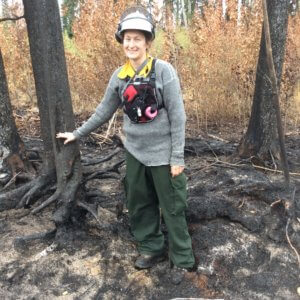 Kelsy Gibos has been a wildfire training specialist with Alberta Wildfire for two years. Gibos previously worked as a wildfire management specialist, calculating wildfire risk at the landscape level. Most of Gibos’s career has been science-based; she has worked as a fire researcher in Canada, Australia and New Zealand and completed a MSc in forestry while studying topographical effects on fire behavior.
Kelsy Gibos has been a wildfire training specialist with Alberta Wildfire for two years. Gibos previously worked as a wildfire management specialist, calculating wildfire risk at the landscape level. Most of Gibos’s career has been science-based; she has worked as a fire researcher in Canada, Australia and New Zealand and completed a MSc in forestry while studying topographical effects on fire behavior.
